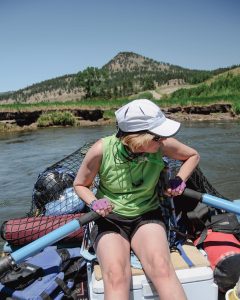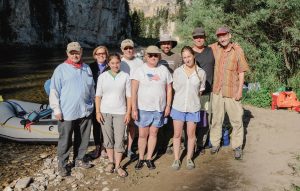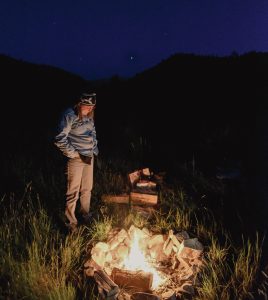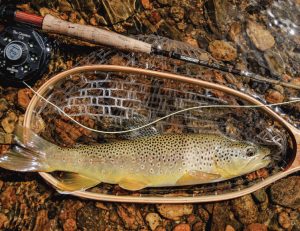
01 Feb Streamside Campfire Elegy
The trout-filled limestone canyon of Montana’s Smith River — twisting through the Big and Little Belt mountains — would have made a magnificent subject for America’s best Western landscape painters and photographers, visionaries like Thomas Moran, Albert Bierstadt, William Henry Jackson, and Ansel Adams. And bluegrass maestro Bill Monroe might have found a sweet, amphitheater- like setting for his music amidst those ponderosa-punctuated gorge walls, too, river purring, stars sparkling overhead.

Floaters prepare to launch at Camp Baker, the put-in for the 59-mile trip down the Smith River. Managed as part of the state park system, the Smith is the only Montana stream requiring a lottery-won permit to float, with only nine parties allowed per day to preserve the remote character.
In their intrepid explorations, the renowned artists never made it to the Smith. But the Lewis and Clark Expedition did — periodically dancing to the campfire fiddling of the one-eyed (French-Omaha) Metis boatman, Pierre Cruzatte — as they labored up the Missouri River toward the Continental Divide. With his usual endearing idiosyncrasies, Meriwether Lewis penned this journal entry on July 15, 1805:
… we dined and just above the entrance of a beautifull river 80 yards wide … which in honor of Mr. Robert Smith the Secretary of the Navy we called Smith’s River. this stream meanders through a most lovely valley to the S.E. for about 25 miles when it enters the Rocky mountains and is concealed from our view. many herds of buffaloe were feeding in this valley
The last time my wife, Mary, and I floated the Smith, we invited seven eclectic friends — sparking improvisational conversations and free-flowing music like a crack bluegrass ensemble. In addition to my estimable Helena colleague, Walt Timmerman, and his wife, Karen, the travelers included Minnesotan Wayne Sames and his two daughters, Emily and Amanda, along with stalwart California pals Bruce Mundt and Dave Foreman. While not everyone knew each other before the float — sometimes a risky proposition on backcountry adventures — it turned out to be an ideal group and our best Smith float ever, slow fishing notwithstanding. Yet, some important things were concealed from our collective view, mysterious until the fateful last day.
A Musician, Herpetologist, and Parks Specialist
I met Walt years prior when we worked together for Montana Fish, Wildlife & Parks (MT FWP). In addition to his outdoor recreation efforts for Montana State Parks, he was a published expert on reptiles and amphibians. As an amateur enthusiast for these creatures since boyhood, I enjoyed hearing his insights and experiences with alligators and other scaly and slimy critters during office downtime. We also engaged in playful trash-talking about our preferred NFL teams (the Minnesota Vikings in my case, the New York Giants in Walt’s). My boasts came crashing down when the Giants punished the Vikes 41–0 in the 2000 NFC Championship Game, but he mercifully never harassed me about it. We stayed in touch periodically after our work years together, and I considered Walt a friend, the kind you make — if you’re fortunate — as working, reasonably responsible, middle-aged males (unlike the wild, crazy, and dangerous teenaged and 20-something-year-old adventures that Bruce and I survived and bonded over decades earlier in middle school, high school, and college).

Mary Vandenbosch works the oars during an idyllic summer day on the Smith River, while the photographer watches the rugged landscape twirl past with a beer.
After I left MT FWP for a new planning job with Lewis and Clark County, Mary and I traveled to Costa Rica’s Monteverde Cloud Forest Biological Reserve. I was stunned to find a guide to the area’s reptiles and amphibians in the visitor center that had been written by Walt when he was doing research in the area. Karen later shared a story and photo from that time, when Walt wrestled a canoe-long, writhing tropical snake he was trying to capture.
Walt was also an exceptional musician, possessing a mandolin once owned by Bill Monroe, which he played in his crack bluegrass band, Bill Junior and the Montana Rangers. Prior to our float, Walt generously compiled a list of classic bluegrass albums he felt I needed to own. He also founded his own Helena-based record company, Lonesome Pine Records, dedicated to traditional American music. Walt was definitely old school when it came to bluegrass, as laid out in tongue-in-cheek fashion on the cover of his 2007 Montana-made album, Can’t You Hear Me Calling:
WARNING! This music adheres to the tradition of Monroe, Flatt & Scruggs, the Stanley Brothers, and Reno & Smiley. Consumers seeking New-grass, Jazz-grass, Psycho-grass, Celtic-grass, Funk-grass, Country-grass, and Crab-grass are advised NOT to buy this album!
Now, I’m open to all those supposed genres, but also respect dedication to purity and authenticity. As further noted by feisty North Carolina bluegrass commentator Flint Hill Flash on the album cover, “Bill Junior and the Montana Rangers have set bluegrass music back 50 years — right where it belongs!”
Fearing water damage on the Smith, Walt wisely left his prized mandolin at home: He purchased a less expensive guitar just for the trip, transporting it between boat camps in an enormous silver tarp secured with a heavy rope. This packaging proved necessary, as Walt and Karen had never floated the Smith before. They relentlessly pin-balled off the limestone walls in their rented raft, breaking Walt’s fishing rod in the process. In spite of these mishaps, Walt proclaimed it “the trip of a lifetime.”
Walt wasn’t feeling well from the beginning, but it didn’t seem like anything serious. Indigestion, he said, with no sense of alarm or emergency. Walt just seemed sluggish and a little grumpy, his usual dry sense of humor not quite as evident. He only broke out his guitar for campfire songs the last two nights on the river. I thought it might just be the intense July heat following our Independence Day launch, which also forced the trout to seek the coolest pool depths, concealed well beneath the surface.
Campfire Concerts
Mary and I were fortunate to hear Bill Junior and the Montana Rangers perform a month prior to our Smith trip, in front of an enthusiastic audience at The Myrna Loy in Helena. In Walt’s “high-lonesome” voice, he sang “Wayfaring Stranger,” which he also did at Paradise Bend, on our third night on the Smith:
I am a poor wayfaring stranger
While traveling through this world of woe
Yet there’s no sickness, toil, or danger
In that bright world to which I go
I’m going there to see my father
I’m going there no more to roam
I’m only going over Jordan
I’m only going over home

The author works terrestrials on a primary Smith River tributary, Sheep Creek, near White Sulphur Springs, Montana. A proposed copper mine in this drainage has stirred considerable controversy, litigation, and local support. The potential for acid mine drainage entering the Smith is a major concern.
On our fourth and last night floating the Smith, as the intense afternoon heat ebbed, Dave dove in the pool below our campsite to cool off, searching for trout loitering on the bottom. I gave some fly-fishing lessons upstream to Amanda and Emily, but the fish weren’t moving. After dark — beneath the seemingly benign indifference of glittering galaxies — Walt gradually marshaled flagging energy outside his tent, playing an incredible concert around the campfire at the Black Butte boat camp, Bruce helping out with harmonica breaks. With fierce old folk, bluegrass, and country cowboy songs — haunting refrains of lost love, deceit, redemption, murder, and, especially, looming mortality — Walt dug deep into his repertoire and even expertly played many requests. He finished with “Will the Circle Be Unbroken?” an icon performed by Bill Monroe, the Carter Family, The Nitty Gritty Dirt Band, and many others:
Will the circle be unbroken
By and by, Lord, by and by?
There’s a better home a-waiting
In the sky, Lord, in the sky
Before launching the next morning, we posed for a group photo on the beach with my tripod and self-timer, next to our rafts and canoe. It was a perfect summer morning at the mouth of the canyon, full of promise, but perhaps the last photo ever taken of Walt.
The Last Day
Thinking back on the song list that final night and the tone in Walt’s voice, it’s almost like he intuitively knew the allotted sand was draining from his hourglass. The next day, on the way to the Eden Bridge take-out, he tumbled out of his raft and Karen had to fish him out.
When Mary and I beached at Eden Bridge — lagging behind due to a swimming stop, oblivious to what occurred downstream — we discovered Walt laying on a picnic table outside the ranger station, under great duress. He was adamant about not calling an ambulance, although Karen finally overruled him. Amazingly, Walt found the energy to profitably sell his guitar to Bruce. Perhaps still looking toward the future, he refused to sell his capo.

The party poses on the fifth and last day of the float, before a morning launch from Black Butte boat camp. From left to right: Walt Timmerman, Mary Vandenbosch, Amanda Sames, Wayne Sames, Karen Timmerman, Dave Foreman, Emily Sames, Bruce Mundt, and author Jeff Erickson. Walt performed his final campfire concert here the night before, on a hill overlooking the Smith.
Once Walt and Karen were gone — Wayne, Emily, and Amanda had already headed back to Minnesota — Mary, Bruce, Dave, and I made for Helena. When we got to our house, a dreadful phone message was waiting like a coiled Smith prairie rattler: Walt died of a catastrophic heart aneurysm in a Great Falls hospital earlier in the evening. There was nothing the doctors could do. Walt’s employer, MT FWP, generously retrieved his gear trailer from the Eden Bridge take-out after he passed away.
It was like an irrevocable death sentence had taken our entire Smith trip to be fully executed and no one — except perhaps Walt’s subconscious mind — seemed to know what was happening until it was over. As author Anne Lamott wrote in a Washington Post essay, “Remember: We’re all on Borrowed Time,” pondering the unraveling threads of aging:
… by a certain age some people beloved to me had died. And then you seriously get real about how short and precious life is. … Some weeks, it feels as though there is a sniper in the trees, picking off people we have loved for years. It breaks your heart, but as Carly Simon sang, there is more room in a broken heart. My heart is the roomiest it has ever been.
Walt’s death was just 24 hours after he brilliantly performed “Bury Me Not on the Lone Prairie” around our last campfire, where the Smith leaves the mountains and hits the rolling, oceanic Great Plains:
I often thought I’d be laid when I die
In the old churchyard by the green hillside
By the side of my father let my grave be
O bury me not on the lone prairie …
I want to be laid where mother’s prayers
And sister’s tears will mingle there
Where friends will come and weep over me
O bury me not on the lone prairie
A few months after Walt’s passing, at a large barn outside Helena, there was a well-attended celebration of his life, with abundant bluegrass music riffing on the beautiful but transitory nature of existence. Given that death is the one absolute certainty we have in life, perhaps meeting your demise on the Smith River, however tragic and premature, isn’t the worst way to go. As Johnny Cash sang in “Oh Come, Angel Band” — among the last songs Walt sang on the Smith:
My latest sun is sinking fast
My race is nearly run
My strongest trials now are past
My triumph hath begun
Oh come, angel band,
Come and around me stand
Oh, bear me away on your snow white wings
To my immortal home

Under a canopy of bright planets and stars, Mary Vandenbosch ponders the mysteries of life and death around a campfire above the Smith River.
Floating and Exploring the Smith River
The remote, 59-mile canyon reach of the Smith River is the only Montana stream requiring a permit to float, with most people taking four days and staying at designated boat camps. Permits are available through a winter lottery held by Montana State Parks, with only nine launch parties allowed per day and a maximum of 15 people per group. Because of the serpentine nature of the river and scattered rapids, intermediate paddling skills are advised, with most floaters employing rafts, canoes, kayaks, or drift boats.

There are options for fishing and exploring the Smith without a float permit. While much of the upper river between White Sulphur Springs and Camp Baker is encompassed by private ranches, there is an inviting exception: The Fort Logan Fishing Access Site and adjacent Smith River Wildlife Management Area sprawl over 3,400 rolling, cliff-rimmed acres, offering primitive camping and room to roam. The river here is smaller than the downstream float section, with minimal boat traffic: wading nirvana.
Many paddlers and fly anglers fear a proposed new copper mine at Black Butte may irreparably harm the Smith River. Underscoring the concern, the conservation group American Rivers listed it as one of the country’s 10 most endangered streams in 2015. If the Black Butte mine clears regulatory requirements and owners Tintina and foreign-held Sandfire Resources proceed with development, it would be located near Sheep Creek, a major tributary and vital spawning refuge for the Smith’s trout, and even fish migrating way up from the Missouri River. This controversy is further complicated by Sandfire’s claims that ore can be extracted without damaging environmental impacts, and the fact that residents and political leaders in nearby White Sulphur Springs widely regard the mine as a source of vital metals, good paying jobs, and an economic boom for a town that has hemorrhaged residents for decades.
Fly Fishing the Smith
Fly fishing the Smith watershed — mostly for wild brown and rainbow trout, with brookies and native westslope cutthroats also present — can run hot and cold depending on water temperatures and flows. The main river often becomes too low to float by mid-July, drawn down by upstream irrigation demands and diminished mountain snowpack. When irrigation season ends in the fall, there may be a sufficient bounce in flows for floating to resume. During mid-summer heat, the canyon walls reflect light into the river, sometimes warming it above 70 degrees — unhealthy for trout — periodically resulting in angling restrictions. So, the window for a perfect float and good fishing can be somewhat narrow. But hit the flows and hatches just right and you’ll enter the gates of paradise, singing gospel like Aretha Franklin around the evening campfire.

Rainbow and brown trout (pictured) are the main quarry for Smith River fly anglers, with brookies and native westslope cutthroats present in some tributaries.
The canyon reach of the Smith is a medium-sized stream, and 4- to 6-weight wands work well, depending on the size of the bugs you’re hurling. One of the wonderful things about the Smith is the diversity of water it offers: riffles, runs, deep pools, bouldery pocket water, foam-lined seams, and spiraling eddies. Working flies close to the limestone walls is productive, as there are subsurface overhangs, cavities, and car-sized limestone chunks providing trout living rooms, like a scene out of a painting by Missoula artist Monte Dolack.
Streamers and meaty stonefly nymphs bounced off cliff walls capture some of the biggest trout, beasts that would look good leering down from the walls of the Stockman Bar in nearby White Sulphur Springs. Hatches are diverse: mixed stoneflies (salmonflies, skwalas, and golden stoneflies), various caddis swarms, midges, and mayflies like blue-winged olives, brown drakes, pale morning/evening duns, mahogany duns, and tricos. Terrestrials and attractors like Madam Xs, Trudes, Turck Tarantulas, Stimulators, Humpies, and Wulffs are often trout candy, especially when paired with a beadhead nymph dropper.
Walt’s Final Set List
Following our float trip and working from memory, Bruce compiled a set list for Walt’s final campfire performance at the Smith River’s Black Butte boat camp, the night before he died. Many songs were requested, illustrating Walt’s musical adaptability.
-
- ”In the Pines” (with Walt yodeling)
- “Oh Come, Angel Band”
- “I’ll Fly Away”
- “The Little Girl & the Dreadful Snake”
- “House of the Rising Sun”
- “Dark as a Dungeon”
- “Bury Me Not on the Lone Prairie”
- “Red River Valley”
- “Streets of Laredo”
- “Footprints in the Snow”
- “Little Cabin Home in the Hills”
- “Wreck of the Old 97”
- “I’m so Lonesome I Could Cry”
- “May the Circle Be Unbroken”
Walt’s live, professional performances are still floating around the internet, located by searching for some variation of “Bill Junior and the Montana Rangers live.”
Early bluegrass, blues, country, and folk music reflected a time when people were much more likely to perish young, like homesteaders in the Smith watershed, as described by Ivan Doig in his acclaimed memoir, This House of Sky. The prospect of early, sudden, inexplicable death seemed more deeply embedded in human consciousness than today.
Noted music critic Greil Marcus offered an insightful take on the essence of this venerable music, in liner notes he wrote for The Basement Tapes, the long “lost,” ancient-sounding 1967 collection of songs by Bob Dylan and The Band. His observations equally apply to the much older American music Walt found rapture in playing: “It is a plain-talk mystery; it has nothing to do with mumbo-jumbo, charms, or spells. The ‘acceptance of death’… in ‘traditional music’ — the ancient ballads of mountain music — is simply a singer’s insistence on mystery as inseparable from any honest understanding of what life is all about; it is the quiet terror of a man seeking salvation who stares into a void that stares back. It is the awesome, impenetrable fatalism that drives the timeless ballads first recorded in the ’20s…”
Jeff Erickson has logged thousands of road miles and 16 years as an environmental, land use, and outdoor recreation planner in Montana and Minnesota. In addition, his stories and photographs have been published in Montana Outdoors, Fly Fisherman, Fly Rod & Reel, and many other publications.



No Comments